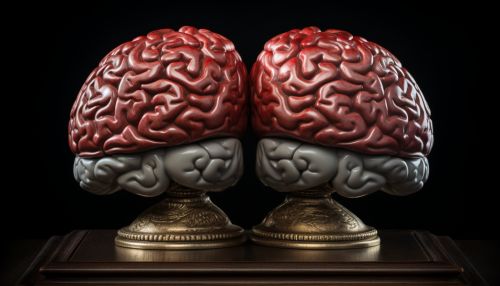Hemispheric specialization
Introduction
Hemispheric specialization, also known as brain lateralization, is the concept that each hemisphere of the brain – the left and the right – has distinct functions and abilities. This idea is a fundamental aspect of neuroscience, cognitive science, and psychology, contributing significantly to our understanding of brain function and human behavior.


Historical Background
The concept of hemispheric specialization has been explored for centuries, with early observations made by physicians and philosophers such as Hippocrates and Galen. However, it was not until the 19th century that the concept began to be scientifically investigated, most notably by French physician Paul Broca. Broca's work with patients suffering from aphasia led to the discovery of the left hemisphere's role in language production, a significant breakthrough in the understanding of brain lateralization.
Theories of Hemispheric Specialization
There are several theories that aim to explain the nature and extent of hemispheric specialization. These include the lateral dominance theory, the equipotentiality theory, and the dichotic listening theory. Each of these theories offers a unique perspective on how the brain's hemispheres function and interact, and they have each contributed to the broader understanding of brain lateralization.


Left Hemisphere Specialization
The left hemisphere of the brain is typically associated with tasks that involve logic, language, critical thinking, and numerical computation. This hemisphere is often referred to as the "dominant" hemisphere, as it controls the right side of the body and is primarily responsible for language processing in about 90% of right-handed individuals and 70% of left-handed individuals.
Language and Speech
One of the most well-known aspects of left hemisphere specialization is its role in language and speech. This includes the production and comprehension of speech, reading and writing, and other language-related tasks. Two key areas involved in these processes are Broca's area and Wernicke's area, both located in the left hemisphere.
Logical and Analytical Thinking
The left hemisphere is also associated with logical and analytical thinking. This includes tasks such as problem-solving, decision-making, and numerical computation. The left hemisphere's approach to these tasks is often sequential and detail-oriented, focusing on individual components before integrating them into a larger whole.


Right Hemisphere Specialization
The right hemisphere, on the other hand, is associated with tasks that involve creativity, spatial ability, facial recognition, and emotional processing. This hemisphere controls the left side of the body and is often referred to as the "non-dominant" hemisphere.
Spatial Ability and Facial Recognition
One of the key areas of right hemisphere specialization is spatial ability. This includes tasks such as navigating, recognizing faces, and interpreting visual imagery. The right hemisphere's approach to these tasks is often holistic, integrating individual components into a larger whole.
Emotional Processing and Creativity
The right hemisphere is also involved in emotional processing and creativity. This includes tasks such as interpreting emotional cues, understanding humor, and engaging in creative thinking. The right hemisphere's approach to these tasks is often intuitive and non-verbal, relying on images and emotions rather than words and logic.


Controversies and Ongoing Research
Despite the widespread acceptance of hemispheric specialization, there are ongoing debates and controversies within the scientific community. These include questions about the extent of lateralization, the impact of handedness, and the potential for neuroplasticity. Ongoing research in these areas continues to refine our understanding of hemispheric specialization and its implications for human behavior and cognition.
